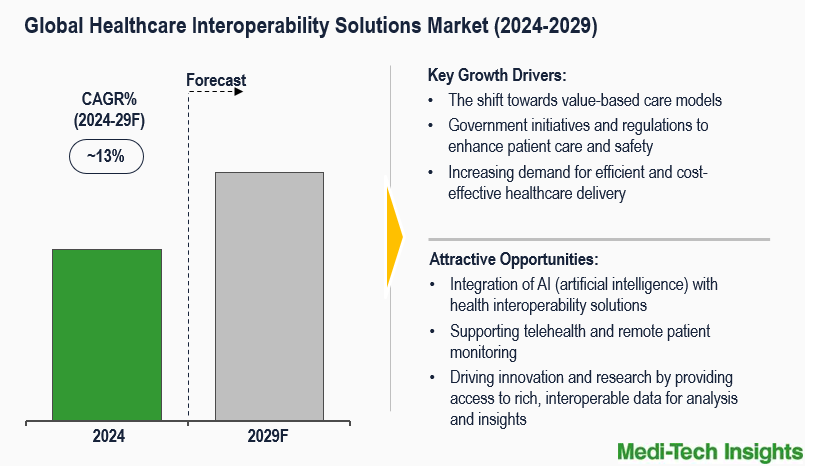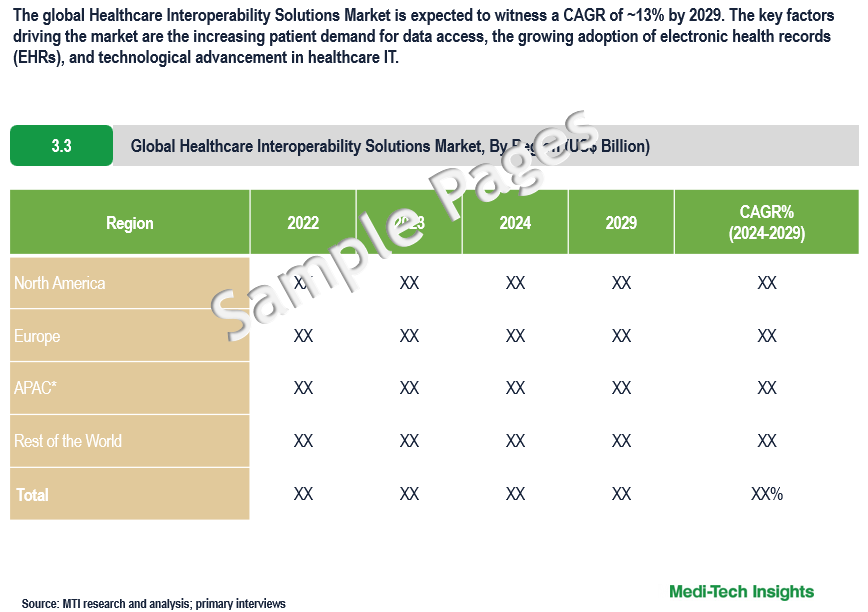
Healthcare Interoperability Solutions Market Size, Share, Growth Analysis and Forecast 2024 to 2029

The Healthcare Interoperability Solutions Market is expected to witness a growth rate of ~13% by 2029. The key factors driving the market are the increasing patient demand for data access, the growing adoption of electronic health records (EHRs), technological advancement in healthcare IT, the shift towards value-based care models, government initiatives and regulations to enhance patient care and safety, and increasing demand for efficient and cost-effective healthcare deliver. To learn more about the research report, download a sample report.
Healthcare interoperability solutions refer to the ability of different electronic systems and devices to communicate and share data effectively. This includes the ability to exchange patient information between different healthcare providers and systems, such as hospitals, clinics, and electronic health records (EHRs), as well as with patients and their devices. Interoperability is classified into four levels: foundational, structural, semantic, and organizational.
- Foundational: Establishes interconnected channels where data can flow to and from two or more health systems.
- Structural: Defines the format of data exchange at the data field level.
- Semantic: Provides codification of data and leverages data in a standardized way as systems share information. Multiple systems can exchange data and use it across disparate systems.
- Organizational: Includes organizational facets to enable secure communication. The data is used both within and between organizations. This process allows for shared consent and cohesive workflows.
Advancement in Healthcare IT Technologies Fuels Its Demand in the Market
Healthcare IT is continuously evolving with the changing demands of systems operations and data accessibility. The number of connected healthcare systems is ever-increasing. Technological advancement in healthcare IT, such as cloud computing, application programming interfaces (APIs), and standards-based protocols like HL7 and FHIR helps to improve the utilization of clinical data and increase operational efficiencies. Some of the advancements in healthcare data interoperability include:
- APIs in Healthcare: APIs make it easier for healthcare providers to achieve software interoperability at internal and cross-organizational levels. They boast a reduced deployment time and provide patients with obstacle-free access to treatment records, lab results, and so on. They act as bridges between two applications, thereby supporting data flow, irrespective of how initially designed the application was. As healthcare is transitioning into value-based care, APIs in a healthcare interoperability platform can ensure that patient data is accessible to the users while safeguarding them from external threats.
- Big data (AI): Machine learning serves as the foundation of AI systems, enabling them to manage the growing volume of health records, clinical notes, and patient forms effectively. This capability allows AI systems to tackle many of the data-handling challenges associated with healthcare interoperability. Furthermore, AI systems possess the capability to generate real-time insights irrespective of the data source.
- Blockchain: Security is vital, particularly during the exchange of substantial volumes of sensitive data. Blockchain emerges as a viable option to bolster security measures. This technology holds significant promise in safeguarding Electronic Health Record (EHR) information from unauthorized access as it transitions between systems. Utilizing blockchain can mitigate the risk of data fraud, whether data exchange occurs internally within a clinic or externally with other stakeholders.
To learn more about this report, download the PDF brochure
Benefits Associated with Healthcare Interoperability Solutions Propels Market Growth
Enhancing healthcare interoperability offers wide-reaching benefits, including the improvement of patient care on a large scale and the creation of opportunities for innovation and research. Some of the benefits include:
- Quality of Care: When providers have access to more information, they can make better decisions regarding patient care. This allows for an integrated healthcare IT system for full access to patient data for the healthcare organization and the patient. A patient's medical history from multiple clinics and hospitals is accessible through one portal, giving providers a full spectrum of procedures and past symptoms. This helps with better diagnostics and preventive care plans that consider all aspects of the patient’s culture, history, and personal habits.
- Reduced Costs: The frictionless exchange of data eliminates redundancies and streamlines administrative tasks. Standardized data formats can be automated for the electronic exchange of patient data, reducing the need for manual effort. This helps lower costs associated with reworks to medical information.
- Efficiency: Health data is easily accessible, diminishes paperwork, and decreases repetitive tasks with the help of real-time results. Providers have precise health information at their fingertips, allowing them to create treatment plans that correlate to patients' historical and current medical issues and needs.
- Increased Patient Engagement: With the advent of patient portals and interoperable mobile health applications, patients gain better access to their medical records. This increased access empowers them to actively participate in their healthcare decisions.
- Enhanced Research: Researchers with access to large amounts of data can spot trends that may not be visible on a smaller scale. Rather than relying on scattered or small samples of patient records, researchers can use a broad range of patient records for more comprehensive studies. Access to a large pool of high-quality data speeds up the research and delivers more reliable results.
Key Constraints/ Challenges
Although there are promising growth opportunities, healthcare organizations encounter several shared challenges when striving to enhance the interoperability of their data and systems. These challenges encompass concerns regarding data privacy and security, the necessity for rapid data transmission, obstacles posed by legacy systems and proprietary formats, the coordination of diverse medical terminologies, intricate mapping of data elements across varied healthcare systems, and the imperative to comply with regulatory mandates. Overcoming these obstacles necessitates collaborative efforts among stakeholders, adherence to interoperability standards, and investments in infrastructure and governance frameworks tailored to interoperability requirements.
North America Expected to Continue to Hold a Major Share in the Healthcare Interoperability Solutions Market
From a geographical perspective, North America holds a major market share of the healthcare interoperability solutions market. This can be mainly attributed to the increasing use of electronic health records (EHRs), growing chronic conditions, rising demand for value-based healthcare, and new government regulations and interoperability rules requiring wider adoption of Fast Healthcare Interoperability Resources (FHIR) in the region. However, the Asia-Pacific region is expected to witness strong growth in the coming years due to increasing adoption and investment in digital healthcare solutions by healthcare providers, rising concerns over increasing healthcare costs, improvement in quality of care and patient experience, and lightening physician burnout in the region.
Competitive Landscape
Some of the key players operating in the market include Allscripts Healthcare LLC, Cerner Corporation, Epic Systems Corporation, Change Healthcare, iNTERFACEWARE Inc., InterSystems Corporation, NextGen Healthcare, Inc., Koninklijke Philips N.V., ViSolve Inc., Orion Health, OSP Labs, AM Healthcare, Deevita LLC, GE Healthcare, and IBM among others.
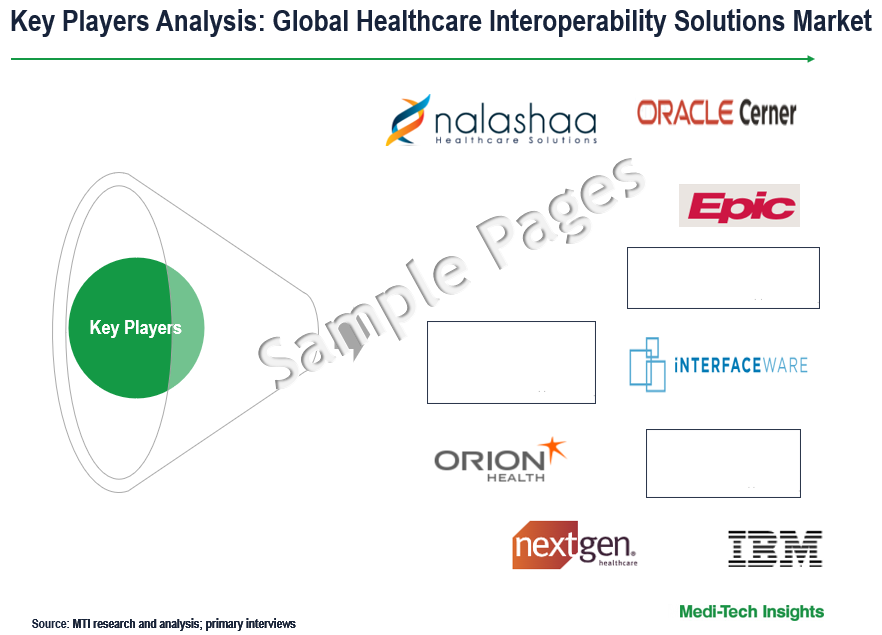
Get a sample report for competitive landscape analysis
Organic and Inorganic Growth Strategies Adopted by Players to Establish Their Foothold in the Market
Players operating in this market are adopting organic and inorganic growth strategies such as launching new products, acquiring related firms, and entering into collaborations to garner higher market share. For instance,
- In February 2024, NextGen Healthcare announced that they have entered into a collaboration with the Serving Communities Health Information Organization (SCHIO), one of the oldest and most advanced multi-stakeholder health information exchanges (HIEs) in the country. This alliance will help California’s medical providers to meet 2024 data exchange regulations by using NextGen Healthcare’s Mirth interoperability solutions, including Mirth Health Data Hub, a data integration and interoperability platform, and Mirth Connect, an integration engine that enables the seamless exchange of health data between various healthcare systems
- In December 2023, Epic announced that its subsidiary Epic Nexus, became one of the first organizations to achieve Qualified Health Information Network (QHIN) designation. Providers using Epic – including many of the country’s leading health systems – can now choose to securely exchange information through the Trusted Exchange Framework and Common AgreementSM (TEFCA), a new national health exchange framework to improve patient care and advance interoperability nationwide
The healthcare interoperability solutions market is a growing market that is expected to gain further momentum in the coming years due to a strong emphasis on developing new interoperability solutions products, innovations in healthcare IT technology, and aggressive organic and inorganic growth strategies followed by the players.
Key Strategic Questions Addressed
-
What is the market size and forecast for the Healthcare Interoperability Solutions Market?
-
What are the historical, present, and forecasted market shares and growth rates of various segments and sub-segments of the Healthcare Interoperability Solutions Market?
-
What are the major growth drivers, restraints/challenges impacting the Healthcare Interoperability Solutions Market?
-
What are the opportunities prevailing in the market?
-
What is the investment landscape?
-
Which region has the highest share in the market? Which region is expected to witness the highest growth rate in the next 5 years?
-
Who are the major players operating in the market? What is the competitive positioning of key players?
-
Who are the new players entering the market?
-
What are the key strategies adopted by players?
- Research Methodology
- Secondary Research
- Primary Research
- Market Estimation
- Market Forecasting
- Executive Summary
- Market Overview
- Market Dynamics
- Drivers
- Restraints
- Opportunities
- Industry Speaks
- Market Dynamics
- Healthcare Interoperability Solutions Market- Size & Forecast (2022-2029), By Type
- Software Solutions
- EHR Interoperability Solutions
- Healthcare Information Exchange Interoperability Solutions
- Imaging System Interoperability Solutions
- Lab System Interoperability Solutions
- Enterprise Interoperability Solutions
- Other Healthcare Interoperability Solutions
- Services
- Software Solutions
- Healthcare Interoperability Solutions Market- Size & Forecast (2022-2029), By Level of Interoperability
- Foundational Interoperability
- Structural Interoperability
- Semantic Interoperability
- Organizational Interoperability
- Healthcare Interoperability Solutions Market- Size & Forecast (2022-2029), By End-Users
- Healthcare Provider
- Hospitals & Clinics
- Long-term Care Centers
- Diagnostics & Imaging Centers
- Other Healthcare Providers
- Healthcare Payers
- Pharmacies
- Other End Users
- Healthcare Provider
- Healthcare Interoperability Solutions Market- Size & Forecast (2022-2029), By Region
- North America (U.S. & Canada)
- Europe (UK, Germany, France, Italy, Spain, Rest of Europe)
- Asia Pacific (China, India, Japan, Rest of Asia Pacific)
- Rest of the World (Latin America, Middle East & Africa)
- Competitive Landscape
- Key Players and their Competitive Positioning
- Competitive Positioning of Key Players (2023)
- Offerings Assessment, By Players
- Key Strategies Assessment, By Player (2021-2023)
- New Service Launches
- Partnerships, Agreements, & Collaborations
- Mergers & Acquisitions
- Other Developments
- Key Players and their Competitive Positioning
- Key Companies Scanned (Indicative List)
- Allscripts Healthcare LLC
- Cerner Corporation
- Epic Systems Corporation
- Change Healthcare
- iNTERFACEWARE Inc.
- InterSystems Corporation
- NextGen Healthcare Inc.
- ViSolve Inc.
- Orion Health
- OSP Labs
- AM Healthcare
- Deevita LLC
- GE Healthcare
- IBM
- Other Prominent Players
The study has been compiled based on extensive primary and secondary research.
Secondary Research (Indicative List)
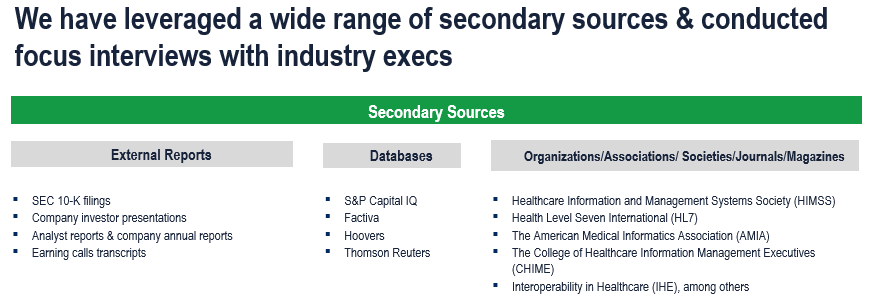
Primary Research
To validate research findings (market size & forecasts, market segmentation, market dynamics, competitive landscape, key industry trends, etc.), extensive primary interviews were conducted with both supply and demand-side stakeholders.
Supply Side Stakeholders:
- Senior Management Level: CEOs, Presidents, Vice-Presidents, Directors, Chief Technology Officers, Chief Commercial Officers
- Mid-Management Level: Product Managers, Sales Managers, Brand Managers, Business Development Managers, Consultants
- Demand Side Stakeholders: Healthcare Providers (Hospitals and Clinics, Long Term Care Centers, Diagnostics & Imaging Centers), Healthcare Payers, and Pharmacies, Among Others.
Breakdown of Primary Interviews
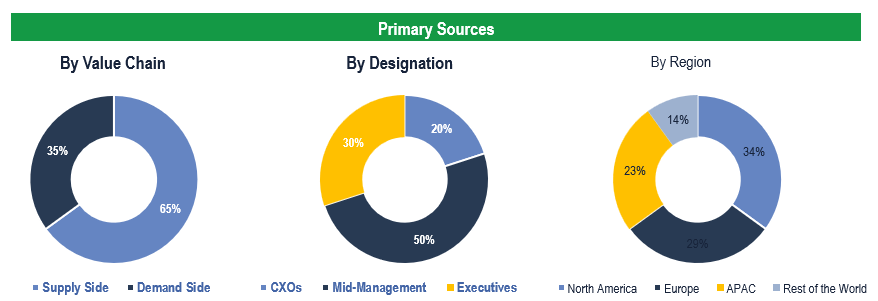
Market Size Estimation
Both ‘Top-Down and Bottom-Up Approaches’ were used to derive market size estimates and forecasts.
Data Triangulation
Research findings derived through secondary sources & and internal analysis were validated with Primary Interviews, an Internal Knowledge Repository, and Company Sales Data.

